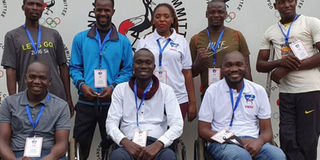How wheelchair rugby is making baby steps

Setting the way: Wanyera (front row centre) and the other members of the fraternity after the coaches’ training course. PHOTO/ABDUL-NASSER SSEMUGABI
What you need to know:
- Shs32m: The cost for a single special wheelchair suitable for the sport. At least 10 are needed for a team.
Richard Ocira has played wheelchair basketball for some years. Wheelchair racing has taken him to the 2018 Berlin Marathon and recently the African Paralympic Games in Tunis. But even with that international exposure, Ocira thought wheelchair rugby is “only for the whites.”
Kizza Kabonge, another wheelchair basketball player, shared Ocira’s thought. They were not so wrong because the only African member of the International Wheelchair Rugby Federation (IWRF) is South Africa, and is ranked bottom on the 31-nation log.
But Ocira and co. know better and are ready to roll after a trainers’ course by the IWRF last month.
“I now know we too can play the sport, and I’m surprised it’s not as rough as the conventional rugby,” says Ocira who travelled from Gulu for the virtual course between April 10 and 24.
Ali Mukasa, arguably the most versatile player in the disability fold, agrees with Ocira that wheelchair rugby is easier than the wheelchair basketball and players will easily love it.
But make no mistakes. The sport was nicknamed ‘murderball’ because it is brutal, high-impact and fast.
History of the sport
According to the IWRF, it is an invasion and evasion game, the object being to carry the ball across the opposing team’s try line to score tries. That involves wheelchairs clashing and though it’s a recipe for injury, the fans love it.
Wheelchair rugby was initially designed for the quadriplegic – people affected by paralysis of all limbs.
Jairus Wanyera is one such person and his search for a sport that suited his disability landed him in the path of wheelchair rugby, also called quad rugby.
“In 2018, I wrote a concept to IWRF for consideration of Uganda,” Wanyera says.
A meeting was convened and thanks to IWRF Development Committee chairperson Cherie Harris, Uganda was included among the countries that could benefit from development programmes.
In 2020, an IWRF report commended Wanyera and his colleagues for their enthusiasm in creating an organisation – Uganda Wheelchair Rugby – to sow the seeds of quad rugby in Uganda.
But the baby steps could have failed without the support of partners in Canada, especially their patron John Greatrex.
“He is the reason all these coaches are here. He has greatly supported us morally and financially,” Wanyera said.
In a Skype call after a training course at the Uganda Olympic Committee, Greatrex told Score that Wanyera and his team were already doing a brilliant job and “I’m willing to help in any way I can.”
The former educator, who worked in Uganda in the 1960s before returning to Coventry, England, believes with support from government and the corporate world, Uganda can even play at the 2022 Commonwealth Games in Birmingham.
That looks a lofty target for an association that lacks wheelchairs, balls and an indoor court. But Greatrex says before the proper support comes, self-motivation and improvisation should be the main driving factors if the sport is to grow.
It makes sense because even South Africa, once ranked 17th in the world, has plunged to 31st because of missing on the international scene for six years, due to inadequate funding.
Way forward
Clyde Holland, South Africa Wheelchair Rugby chairman, who was also part of the zoom training course, recently said that their biggest challenge is lack of standard adaptive chairs. He said a new wheelchair costs R130,000 (Shs32m). A 10-man team would cost Shs320m for only wheelchairs.
Desperate to compete at the Paralympics one day, South Africa has resorted to manufacturing their own wheelchairs, which are likely to be five times cheaper.
For now, Denis Ouma, Uganda Wheelchair Rugby publicist, said they are due to sign a memorandum of understanding with Kampala Wheelchair Basketball to share the resources.
Sulaiman Mayanja, president of Uganda Wheelchair Basketball Federation, hopes this grows into a symbiotic relationship for the good of both sports.
“These sports are intertwined and we are sharing a playing field, the chairs, and almost 90 percent of the players,” he said, adding that they decided to train in both games at Makerere University every Tuesday and Thursday, “though the wheelchairs are too old.”
Despite the financial constraints, South Africa has about 10 wheelchair rugby clubs, a national league and interprovincial tournament played each year.
Wanyera and co. envisage something similar, but as their patron advised, “it begins with improvisation, and self-motivation.”
Quad rugby...Understanding the sport
Canadian Duncan Campbell founded quad rugby in 1976, with the first competition in Edmonton in 1977. The sport has since gone international, with World Championships and Paralympic.
There are several variants of wheelchair rugby, but the international version is played between two teams of four players each on a basketball-sized court.
Players are chosen according to their level of disability, ranging from 0.5 to 3.5. The higher the number the lower the level of physical limitation. Players with a classification of 0.5 usually play defence, while those with the highest classification play different roles. Players whose classification higher than 8.0 cannot take part.
A match is played in four quarters, each lasting eight minutes. A try is scored when a player crosses the opposition’s eight-metre try-line with two of their wheels.
Australia, USA, Japan, Britain and Canada are the top five.




